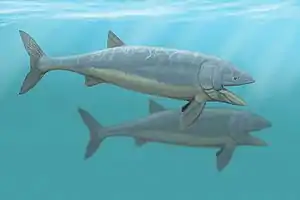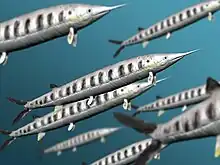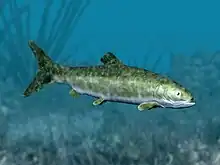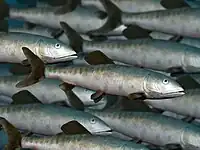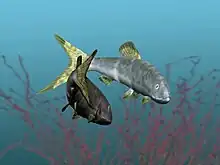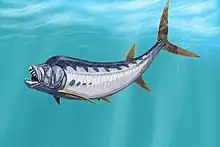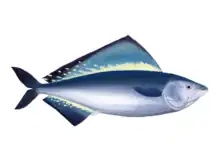| Bachea Temporal range: Turonian ~ | |
|---|---|
 | |
| Holotype specimen of B. huilensis | |
| Scientific classification | |
| Domain: | Eukaryota |
| Kingdom: | Animalia |
| Phylum: | Chordata |
| Class: | Actinopterygii |
| Order: | †Tselfatiiformes |
| Family: | †Plethodidae |
| Genus: | †Bachea Páramo, 1997 |
| Species: | †B. huilensis |
| Binomial name | |
| †Bachea huilensis Páramo, 1997 | |
Bachea is an extinct genus of ray-finned fish that lived during the Late Cretaceous in what is now central Colombia, South America. The type species is Bachea huilensis, described in 1997 by María Páramo from the Turonian of Huila, Colombia.
Description
The genus name Bachea is derived from the Baché River in Huila and the specific epithet refers to the Huila Department, where the fossils were found. The fish is placed in the suborder Tselfatoidei, but the family placement is uncertain.[1] The fossil find is the first specimen from the suborder in Colombia, extending their distribution.[2]
The fish had a tall body with the dorsal fin folded along the back of the body. The mouth was relatively small, with extruding teeth.[2] These characteristics are found in part in other early Late Cretaceous fish, such as Concavotectum moroccensis from the Kem Kem Beds of Morocco.[3] The several specimens found range from 0.5 to 1 metre (20 to 39 in) in length, making Bachea one of the larger forms in their order.[4] They are considered to have lived in a coastal environment and probably had a scavenger diet.[2]
Paleoecology

90 Ma, by Ron Blakey
The fossils of Bachea huilensis were reported to have been found in the La Frontera Formation of the Villeta Group, a formation dating to the Turonian. As the mosasaur Yaguarasaurus columbianus,[5][6] reported from the same formation, the La Frontera Formation has not been mapped south of Cundinamarca. The time-equivalent formations of the La Frontera Formation, which is restricted to the central Eastern Ranges of the Colombian Andes, are the Hondita and Loma Gorda Formations (pertaining to the Güagüaquí Group) from the south-central Upper Magdalena Valley and surrounding Eastern and Central Ranges.[7][8] These formations were deposited in a relative highstand sequence with an oceanic oxygen depletion event in the seaway present in the Late Cretaceous in northwestern South America.[9] Other fossil fish found from this period are Pachyrhizodus etayoi also from Turonian Huila,[10] and Candelarhynchus padillai from the San Rafael Formation,[11] which is also rich in ammonite fauna and preserves crustaceans.[12]
The Turonian to early Coniacian Loma Gorda Formation has provided many genera of ammonites,[13] while the underlying Hondita Formation is poorer in these cephalopods and probably dates to the Cenomanian.[14]
References
- ↑ Páramo, 1997
- 1 2 3 García Rodríguez, 2015, p.35
- ↑ Cavin & Forey, 2008, p.199
- ↑ Vernygora et al., 2017, p.2
- ↑ Yaguarasaurus columbianus at Fossilworks.org
- ↑ Páramo Fonseca, 2000, p.124
- ↑ Plancha 344, 1999
- ↑ Plancha 345, 1999
- ↑ Villamil, 2012, p.173
- ↑ Castelblanco & Vásquez, 2016
- ↑ Vernygora et al., 2017, p.5
- ↑ Patarroyo & Rojas, 2007, p.92
- ↑ Patarroyo, 2011, p.72
- ↑ Patarroyo, 2011, p.82
Bibliography
- Castelblanco Cárdenas, Lilia Milena, and Luis Eduardo Vásquez Salamanca. 2016. Fósil del mes - Pachyrhizodus etayoi, 1. Servicio Geológico Colombiano. Accessed 2019-03-13.
- Cavin, Lionel, and Peter L. Forey. 2008. A new tselfatiiform teleost from the Upper Cretaceous (Cenomanian) of the Kem Kem beds, Southern Morocco, 199–216. Mesozoic Fishes 4 – Homology and Phylogeny, G. Arratia, H.-P. Schultze & M. V. H. Wilson (eds.). Accessed 2019-03-13.
- García Rodríguez, Viviana Marcela. 2015. Estrategia didáctica para la enseñanza de fósiles hallados en Colombia (M.A. thesis), 1–93. Universidad Nacional de Colombia. Accessed 2019-03-13.
- Páramo Fonseca, María Euridice. 2000. Yaguarasaurus columbianus (Reptilia, Mosasauridae), a primitive mosasaur from the Turonian (Upper Cretaceous) of Colombia. Historical Biology 14. 121–131. Accessed 2019-03-13.
- Páramo, María E. 1998. Platypterygius sachicarum (Reptilia, Ichthyosauria) nueva especie del Cretácico de Colombia. Revista INGEOMINAS 6. 1–12. .
- Páramo, María. 1997. Bachea huilensis nov. gen., nov. sp., premier Tselfatioidei (Teleostei) de Colombie. Comptes Rendus de l'Académie des Sciences, Série IIA 325. 147–150. Accessed 2019-03-13.
- Patarroyo, Pedro. 2011. Sucesión de Amonitas del Cretácico Superior (Cenomaniano-Coniaciano) de la parte más alta de la Formación Hondita y de la Formación Loma Gorda en la Quebrada Bambucá, Aipe - Huila (Colombia). Boletín de Geología 33. 69–92. Accessed 2019-03-13.
- Patarroyo, Pedro, and Alexis Rojas. 2007. La sucesión y la fauna del Turoniano de la Formación San Rafael en Pesca y su comparación con la sección tipo en Samacá (Boyacá, Colombia - S.A.) - Turonian succession and fauna of the San Rafael Formation in Pesca and its comparation with the type section in Samacá (Boyacá - Colombia S.A.). Geología Colombiana 32. 89–96. Accessed 2019-03-13.
- Vernygora, Oksana; Alison M. Murray; Javier Luque; Mary Luz Parra Ruge, and María Euridice Páramo Fonseca. 2017. A new Cretaceous dercetid fish (Neoteleostei: Aulopiformes) from the Turonian of Colombia. Journal of Systematic Palaeontology _. 1–15. Accessed 2019-03-13.
- Villamil, Tomas. 2012. Chronology Relative Sea Level History and a New Sequence Stratigraphic Model for Basinal Cretaceous Facies of Colombia, 161–216. Society for Sedimentary Geology (SEPM).
- Maps
- Marquínez, Germán; C. Morales, and Alberto Núñez. 1999. Plancha 344 - Tesalia - 1:100,000, 1. INGEOMINAS. Accessed 2017-06-06.
- Velandia, F.; C.J. Morales; J.C. Caicedo, and Alberto Núñez. 1999. Plancha 345 - Campoalegre - 1:100,000, 1. INGEOMINAS. Accessed 2017-06-06.
